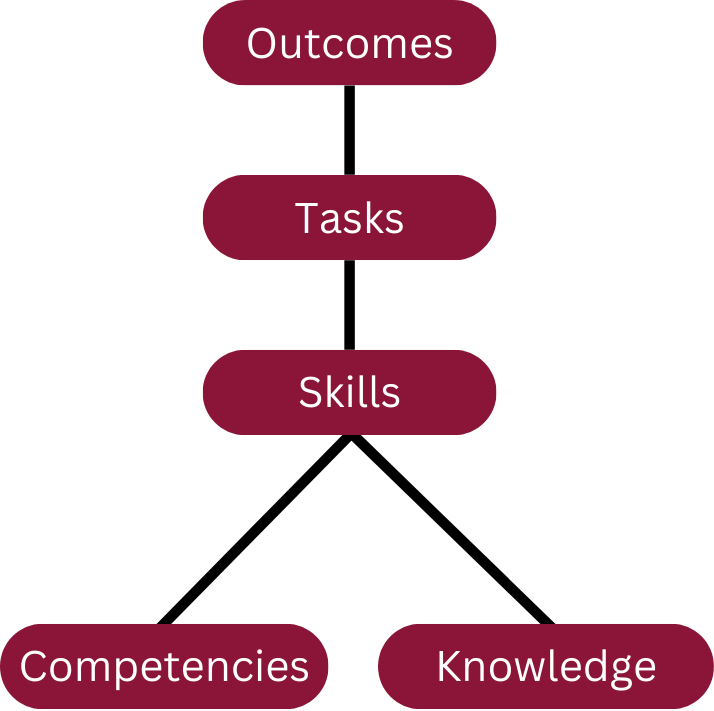While nonprofits, higher education institutions, and mission-driven organizations have traditionally looked within their own sectors to find and develop talent and leadership, we are finding that they’re increasingly open to the idea of bringing in talent from outside traditional pipelines. Why is this happening?
Talent scarcity for leadership roles remains a significant hurdle, especially in the nonprofit sector. At the same time, many institutions are reassessing job requirements, like educational credentials or highly specific industry experience, that have long served as sometimes unnecessary barriers to otherwise highly qualified candidates.
Together, these factors are driving a change in attitude regarding how and where organizations search for talent. A change in attitude, however, does not automatically translate into a change in practices. If, at the beginning of your search, you’re committed to building a pool that includes candidates with transferable skills, how can you follow through on this commitment and embed it into your overall recruiting strategy?
Why Recruiting Nontraditional Candidates Is So Beneficial (and So Challenging)
Nontraditional candidates—candidates with different kinds of career backgrounds and professional experiences than usually found in a given field—bring fresh perspectives to organizations. Drawing on their varied backgrounds and experiences, these leaders can help organizations approach problems differently and develop innovative solutions. This diversity of thought is crucial for organizations looking to remain competitive, productive, and adaptable in a rapidly changing environment.
It’s clear that organizations want (and need) different kinds of candidates in order to build wider and more compelling candidate pools for leadership positions. Hiring leaders recognize the limitations of narrow traditional pipelines in yielding the most qualified or innovative leaders. They understand that experienced candidates with nontraditional career backgrounds and transferable skills can bring renewed energy and push organizations in new, productive directions.
However, as a Harvard Business Review study recently revealed, “there’s a big disconnect between what job ads say and what employers do.” We are finding that, despite real enthusiasm for recruiting approaches designed to bring more candidates to the table, hiring managers still face significant obstacles to taking the next step. If a candidate lacks standard credentials and qualifications, hiring managers tend not to linger long enough to consider the relevant skills that the candidate does have. Or they can struggle to parse candidates’ resumes for signs of important potential.
These are common and understandable problems. It can be challenging to imagine someone in a role when their path to that role looks so different from successful candidates in the past—and the potential costs when new hires don’t work out can lead to a preference for familiar, low-risk candidates.
If this sounds familiar, you might find yourself asking: where do I go from here?
Insights for Your Inbox
Subscribe to access the latest executive recruiting trends, resources for talent engagement, and open searches and career opportunities.
Getting to the Essence of the Role
Having worked closely with professionals across a range of functional areas in the nonprofit world, we have found that, to connect the dots between candidates’ resumes and the requirements of the open position, hiring managers must engage in a process of deconstruction.
Both resumes and job requirements must be broken down into their most basic components. These components, known as competencies, are a set of fundamental abilities needed to successfully implement skills and complete tasks.
If the resume’s competencies match the job requirement’s competencies, there is a good chance the candidate has the transferable skills you are looking for. And while this is a process that demands careful planning, creative thinking, and a reassessment of conventional hiring patterns, matching the right candidate with the right role leads to better outcomes and more engaged teams down the road.
Transferable Skills vs. Transferable Competencies
Both transferable skills and transferable competencies are key abilities that apply across various industries, but they have different scopes and applications.
Transferable skills is the terminology you are most likely to encounter in the job market; but to get to the fundamental essence of the leadership role, we suggest focusing on transferable competencies.
Skills are specifically focused and applied abilities needed to complete tasks successfully. Examples of skills could be coding, foreign languages, or public speaking.
Competencies are fundamental abilities used to effectively deploy skills and succeed holistically in a job; they are also often honed over time and through work and life experiences. These can be broadly applied to many kinds of tasks and in many different settings; therefore, readiness and measurement need to be mapped to the particular role. Competencies can include relationship building, problem solving, critical thinking, conflict resolution, and integrity.
Skills emerge from a particular knowledge base and are activated by competencies. If your organization is unable to train new hires in a particular skill (technical knowledge of a programming language or legal expertise, for example), you may elect to downgrade the importance of competencies and instead evaluate candidates based on the specialized knowledge and skills they already possess.
However, an overly narrow focus on skills may limit your search to traditional pipelines, causing you potentially to miss an entire pool of exciting, beyond-the-box prospects. Hiring based on competencies, on the other hand, not only promotes innovation and industry cross-pollinations but can also help reduce unconscious bias that hiring managers may have toward more familiar candidate backgrounds.
These competencies, including relationship building, communication, leadership, and adaptability, are universally valuable and can be developed through experiences that diverge from conventional career paths. They are the building blocks that leaders and managers can use to train highly effective personnel and move them into new, emerging roles as an organization’s workforce needs evolve.
How to Focus on Competencies
To reverse-engineer competencies from the skills you require, we recommend that you move beyond industry-specific terms and break down job descriptions into their core components.
Identify Essential Tasks. Start by analyzing the job description and identifying the key tasks required for the position. What is the end goal of this position and what day-to-day activities are required to achieve it?
For example, if you are building bookshelves, the tasks might include reading design plans, measuring and cutting materials, assembling parts, and quality assurance.
Translate Tasks into Skills. Every task requires a set of specific skills to be successfully accomplished. Work with the incumbent or study adjacent positions in peer institutions to understand key skills. This is also an opportunity to articulate which skills are absolutely necessary for the position and which are in the nice-to-have category.
Sticking with the example above, essential skills needed to measure and cut materials could include proficiency with certain tools and the ability to measure accurately, while nice-to-have skills might be experience working with specific woods or decorative woodwork.
Deduce Competencies from Skills. Drill one level deeper to understand the knowledge and competencies that support the skills that are important to your organization. Knowledge should be industry- or company-specific information that will be part of the training and onboarding process, while competencies are more fundamental abilities like communication, emotional intelligence, or analytic reasoning.
Proficiency with specific tools requires knowledge of how the tools function and how to properly use them. Also of critical importance are competencies like manual dexterity, attention to detail, patience, and problem solving. Someone with these competencies could likely be trained to successfully measure and cut bookshelf materials.

You probably have the tools you need to create competencies out of your job description. Once you start reviewing resumes and interviewing candidates, however, you may find it challenging to stay focused on how their skills and accomplishments reflect their underlying competencies.
To prepare for these later stages of the search, familiarize yourself with competency models that are publicly available. Many of these models are created by experts in their fields who have thought deeply about the various abilities, values, and experiences needed to succeed in these sectors. They can be powerful tools in vetting candidates from those industries. Examples include the CASE Competency Model for institutional advancement or the Dorothy A. Johnson Center’s Nonprofit Competency Model for Inclusive Leadership.
It can also be useful to partner with leadership peers in the industries you are targeting or work with recruiters who have a broad understanding of how skills and competencies translate across multiple functional areas. These experts can help bring resumes to life, doing the deconstructing work on candidates’ resumes and crafting narratives that explain how unconventional career paths have equipped candidates with necessary competencies.
Post-Hire Support
Successfully hiring candidates doesn’t end when they sign on the dotted line. Ensure new hires don’t encounter a glass cliff—struggling to succeed due to lack of institutional support—by taking time to understand deeply the different kinds of needs and training incoming leaders require to perform to their potential.
Organizations need to determine which skills are trainable and which skills candidates need to bring to the table. The good news is if you’ve followed the steps outlined above, you’ve already done most of this work. Return to your breakdown of skills and develop a training plan based on the industry and organizationally specific information candidates will need in order to activate the competencies they bring to the role.
Of course, your incoming hire will need additional support beyond skills-based training. For example, someone with a corporate background may have to adjust to the pace, goals, and unspoken expectations of a nonprofit or university environment. A new leader may bring a strong relationship-building competency, but may need guidance navigating cultural norms and internal dynamics within an organization. To fully realize the creativity, innovation, and energy your new hire can bring to their position, try to continuously engage them through mentorship programs, ongoing feedback, and opportunities for professional development.
Conclusion
Recruiting nontraditional candidates with transferable skills requires both a shift in mindset and approach. By recognizing the value of expanded backgrounds and experiences, organizations can tap into a larger pool of qualified candidates and drive innovation and resilience in their workforce. With the support of experienced recruiters and a commitment to considering the competencies that truly create a foundation for success, you can effectively integrate nontraditional candidates and reap the benefits of their fresh perspectives and unique skills.
Your Nonprofit Executive Search Partner
At Lindauer, we partner with mission-driven organizations to find the leaders who will propel their causes forward.

